Audit Issues of SCG: Comprehensive Analysis of Audit and Financials
VerifiedAdded on 2023/01/05
|16
|3203
|65
Report
AI Summary
This report examines the audit issues of Scentre Group (SCG), focusing on materiality, financial performance, and audit assertions. It analyzes key financial ratios, including return on investment, EBITDA margin, and net profit margin, comparing SCG's performance against industry averages. The report covers the application of materiality in auditing, the importance of financial statement assertions (existence, completeness, rights and obligations, accuracy and valuation, and presentation and disclosure), and an overview of SCG's cash flow from operations. The analysis highlights areas of concern, such as declining year-on-year return on investment, and provides insights into the company's financial health and operational efficiency. This report is a valuable resource for understanding the financial aspects of SCG and the related audit considerations.
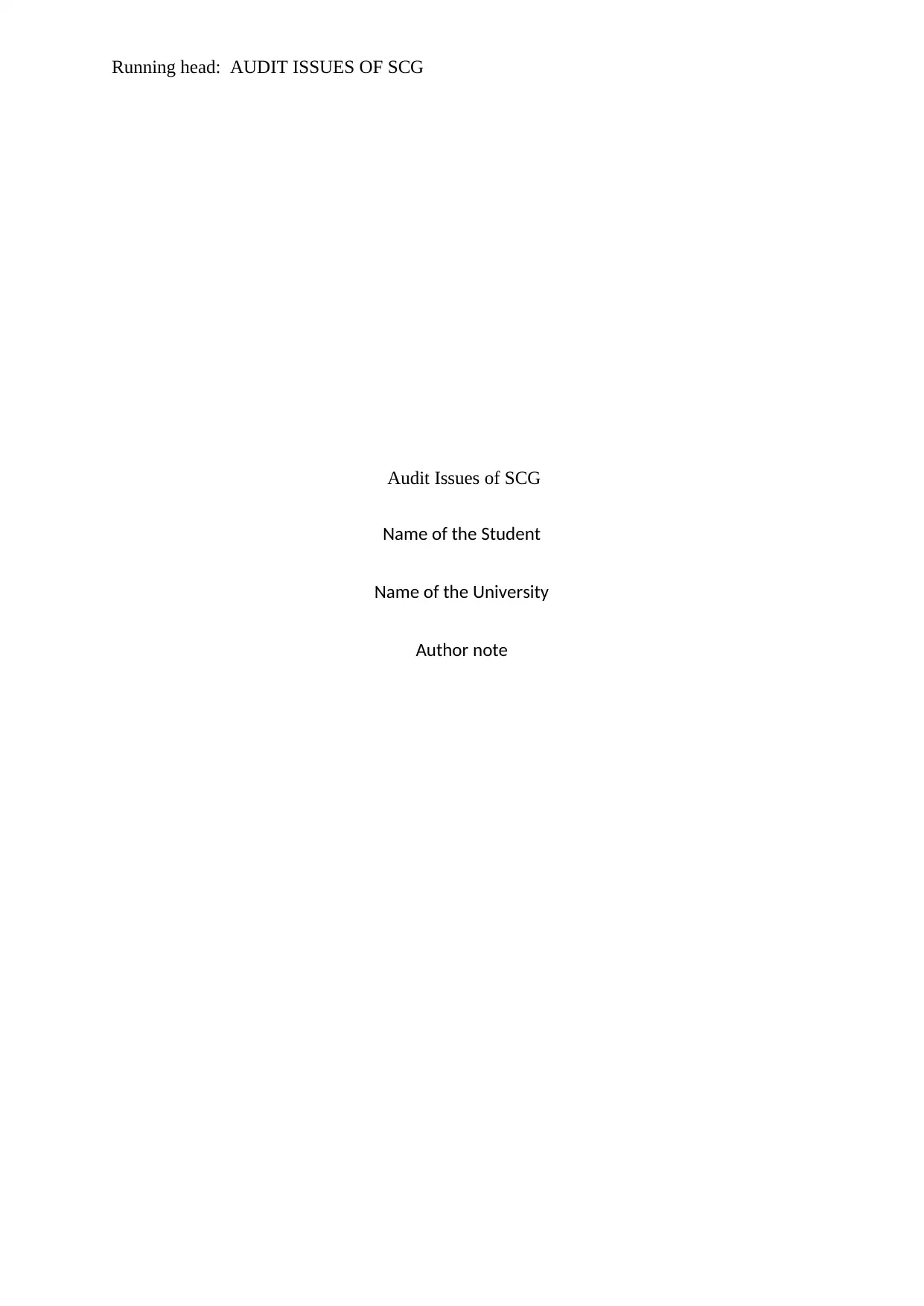
Running head: AUDIT ISSUES OF SCG
Audit Issues of SCG
Name of the Student
Name of the University
Author note
Audit Issues of SCG
Name of the Student
Name of the University
Author note
Paraphrase This Document
Need a fresh take? Get an instant paraphrase of this document with our AI Paraphraser
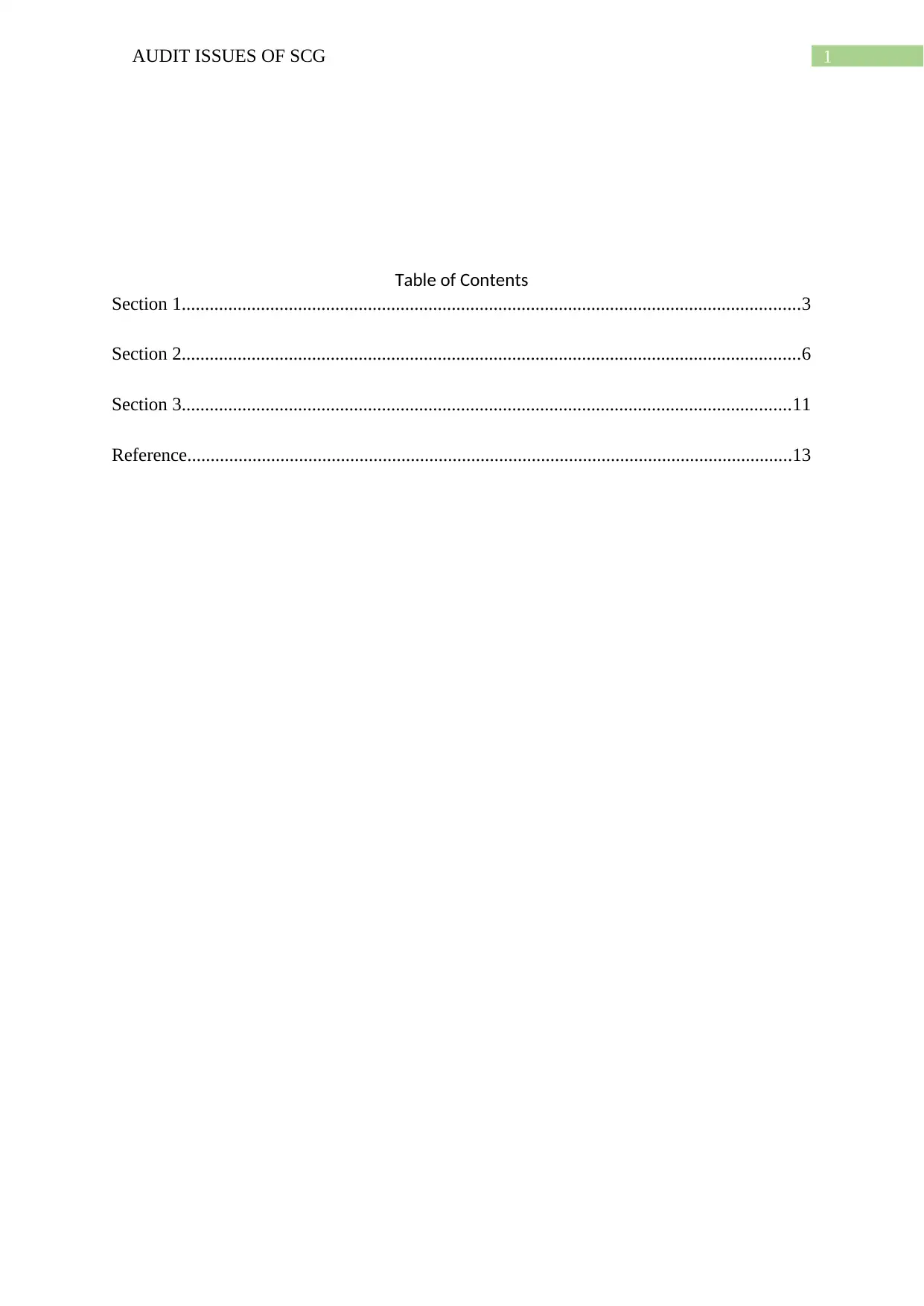
1AUDIT ISSUES OF SCG
Table of Contents
Section 1.....................................................................................................................................3
Section 2.....................................................................................................................................6
Section 3...................................................................................................................................11
Reference..................................................................................................................................13
Table of Contents
Section 1.....................................................................................................................................3
Section 2.....................................................................................................................................6
Section 3...................................................................................................................................11
Reference..................................................................................................................................13
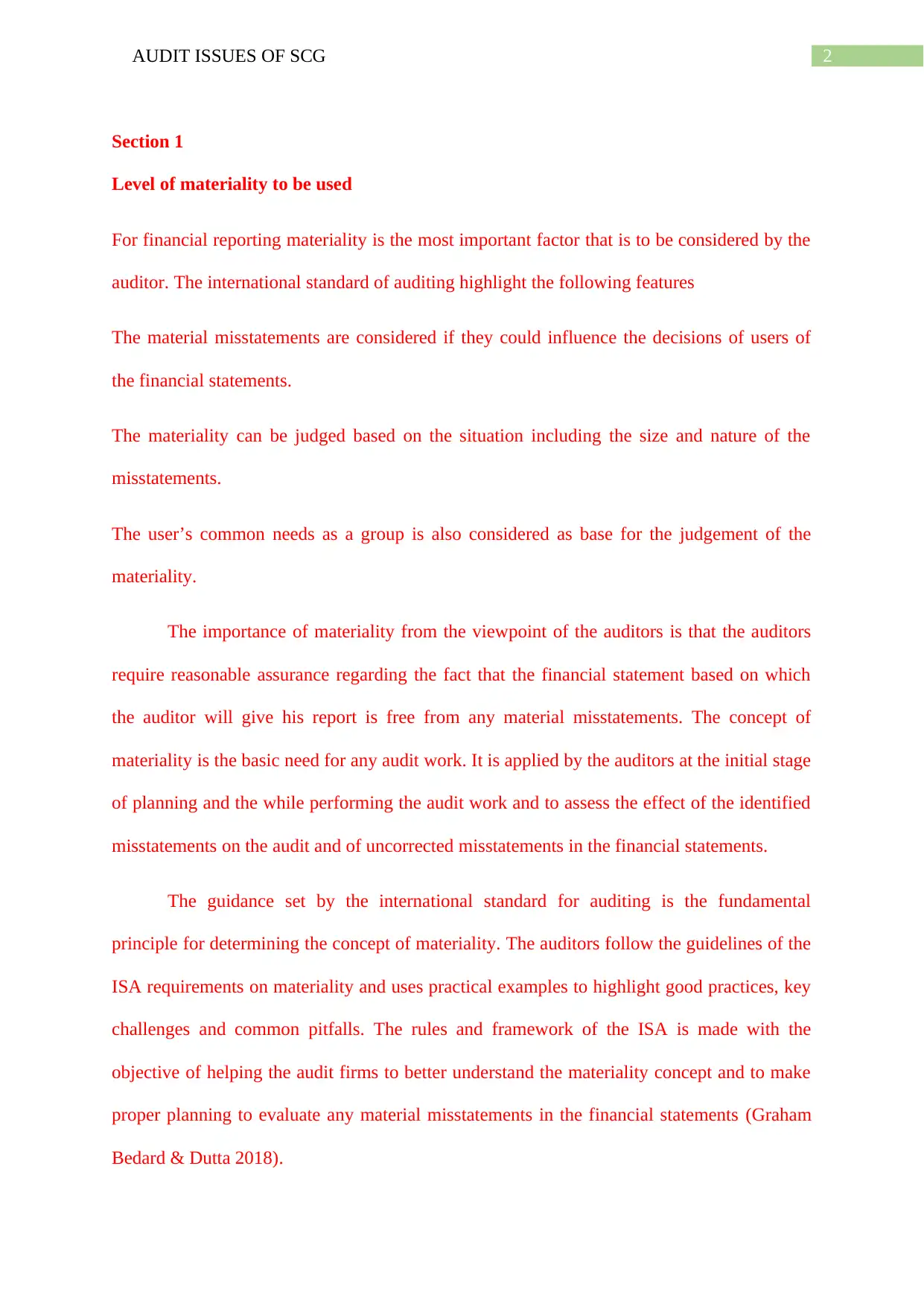
2AUDIT ISSUES OF SCG
Section 1
Level of materiality to be used
For financial reporting materiality is the most important factor that is to be considered by the
auditor. The international standard of auditing highlight the following features
The material misstatements are considered if they could influence the decisions of users of
the financial statements.
The materiality can be judged based on the situation including the size and nature of the
misstatements.
The user’s common needs as a group is also considered as base for the judgement of the
materiality.
The importance of materiality from the viewpoint of the auditors is that the auditors
require reasonable assurance regarding the fact that the financial statement based on which
the auditor will give his report is free from any material misstatements. The concept of
materiality is the basic need for any audit work. It is applied by the auditors at the initial stage
of planning and the while performing the audit work and to assess the effect of the identified
misstatements on the audit and of uncorrected misstatements in the financial statements.
The guidance set by the international standard for auditing is the fundamental
principle for determining the concept of materiality. The auditors follow the guidelines of the
ISA requirements on materiality and uses practical examples to highlight good practices, key
challenges and common pitfalls. The rules and framework of the ISA is made with the
objective of helping the audit firms to better understand the materiality concept and to make
proper planning to evaluate any material misstatements in the financial statements (Graham
Bedard & Dutta 2018).
Section 1
Level of materiality to be used
For financial reporting materiality is the most important factor that is to be considered by the
auditor. The international standard of auditing highlight the following features
The material misstatements are considered if they could influence the decisions of users of
the financial statements.
The materiality can be judged based on the situation including the size and nature of the
misstatements.
The user’s common needs as a group is also considered as base for the judgement of the
materiality.
The importance of materiality from the viewpoint of the auditors is that the auditors
require reasonable assurance regarding the fact that the financial statement based on which
the auditor will give his report is free from any material misstatements. The concept of
materiality is the basic need for any audit work. It is applied by the auditors at the initial stage
of planning and the while performing the audit work and to assess the effect of the identified
misstatements on the audit and of uncorrected misstatements in the financial statements.
The guidance set by the international standard for auditing is the fundamental
principle for determining the concept of materiality. The auditors follow the guidelines of the
ISA requirements on materiality and uses practical examples to highlight good practices, key
challenges and common pitfalls. The rules and framework of the ISA is made with the
objective of helping the audit firms to better understand the materiality concept and to make
proper planning to evaluate any material misstatements in the financial statements (Graham
Bedard & Dutta 2018).
⊘ This is a preview!⊘
Do you want full access?
Subscribe today to unlock all pages.

Trusted by 1+ million students worldwide
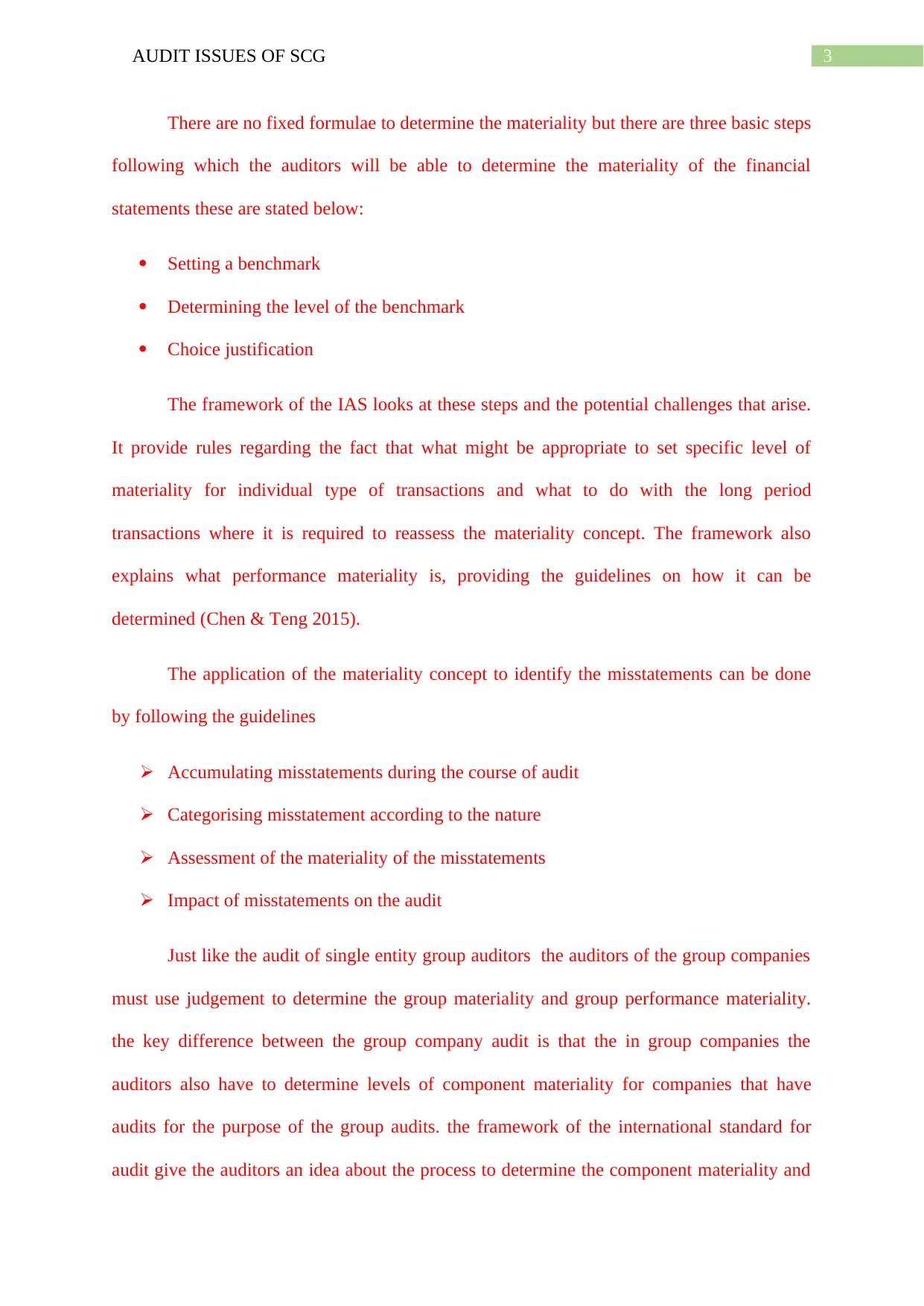
3AUDIT ISSUES OF SCG
There are no fixed formulae to determine the materiality but there are three basic steps
following which the auditors will be able to determine the materiality of the financial
statements these are stated below:
Setting a benchmark
Determining the level of the benchmark
Choice justification
The framework of the IAS looks at these steps and the potential challenges that arise.
It provide rules regarding the fact that what might be appropriate to set specific level of
materiality for individual type of transactions and what to do with the long period
transactions where it is required to reassess the materiality concept. The framework also
explains what performance materiality is, providing the guidelines on how it can be
determined (Chen & Teng 2015).
The application of the materiality concept to identify the misstatements can be done
by following the guidelines
Accumulating misstatements during the course of audit
Categorising misstatement according to the nature
Assessment of the materiality of the misstatements
Impact of misstatements on the audit
Just like the audit of single entity group auditors the auditors of the group companies
must use judgement to determine the group materiality and group performance materiality.
the key difference between the group company audit is that the in group companies the
auditors also have to determine levels of component materiality for companies that have
audits for the purpose of the group audits. the framework of the international standard for
audit give the auditors an idea about the process to determine the component materiality and
There are no fixed formulae to determine the materiality but there are three basic steps
following which the auditors will be able to determine the materiality of the financial
statements these are stated below:
Setting a benchmark
Determining the level of the benchmark
Choice justification
The framework of the IAS looks at these steps and the potential challenges that arise.
It provide rules regarding the fact that what might be appropriate to set specific level of
materiality for individual type of transactions and what to do with the long period
transactions where it is required to reassess the materiality concept. The framework also
explains what performance materiality is, providing the guidelines on how it can be
determined (Chen & Teng 2015).
The application of the materiality concept to identify the misstatements can be done
by following the guidelines
Accumulating misstatements during the course of audit
Categorising misstatement according to the nature
Assessment of the materiality of the misstatements
Impact of misstatements on the audit
Just like the audit of single entity group auditors the auditors of the group companies
must use judgement to determine the group materiality and group performance materiality.
the key difference between the group company audit is that the in group companies the
auditors also have to determine levels of component materiality for companies that have
audits for the purpose of the group audits. the framework of the international standard for
audit give the auditors an idea about the process to determine the component materiality and
Paraphrase This Document
Need a fresh take? Get an instant paraphrase of this document with our AI Paraphraser
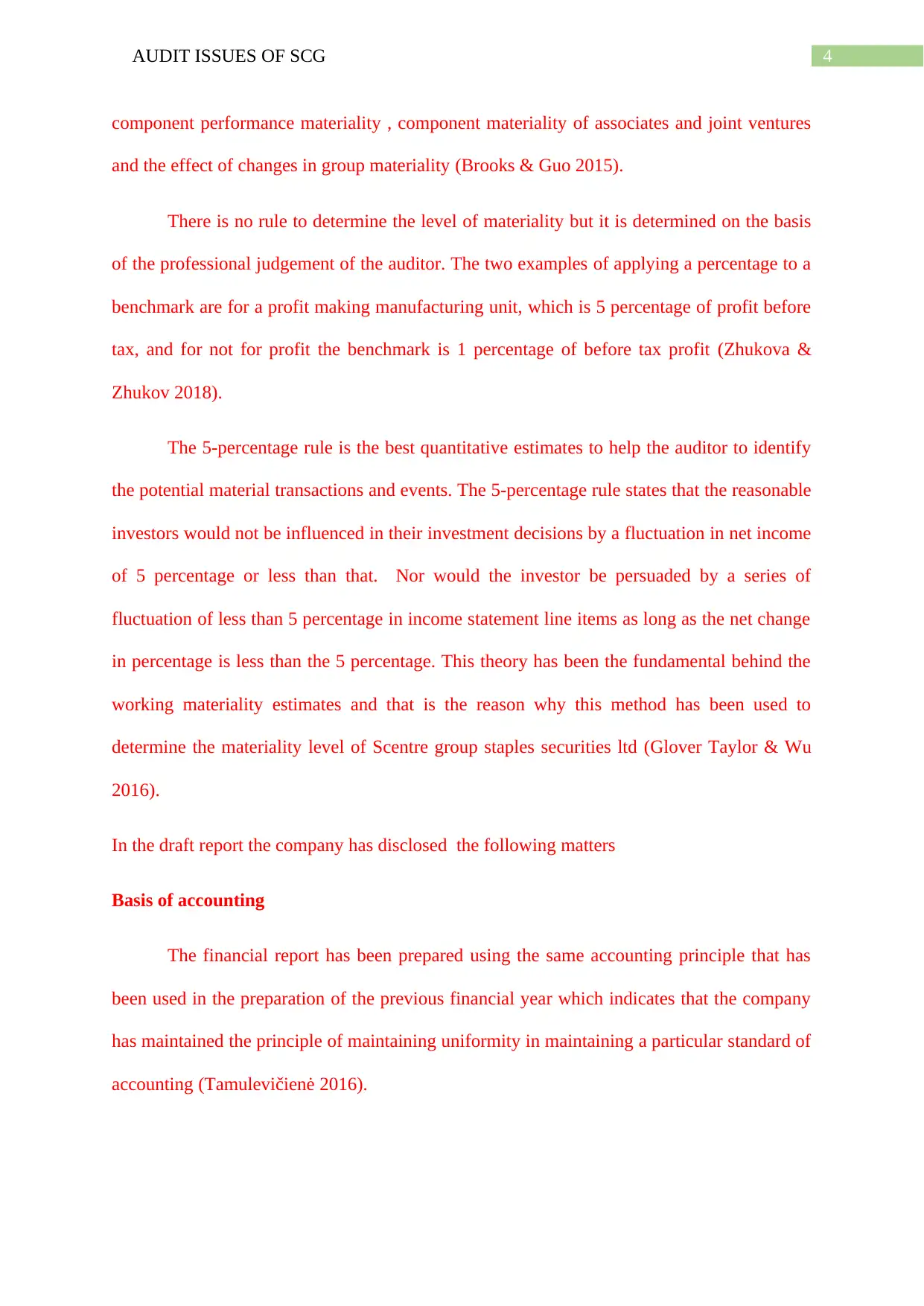
4AUDIT ISSUES OF SCG
component performance materiality , component materiality of associates and joint ventures
and the effect of changes in group materiality (Brooks & Guo 2015).
There is no rule to determine the level of materiality but it is determined on the basis
of the professional judgement of the auditor. The two examples of applying a percentage to a
benchmark are for a profit making manufacturing unit, which is 5 percentage of profit before
tax, and for not for profit the benchmark is 1 percentage of before tax profit (Zhukova &
Zhukov 2018).
The 5-percentage rule is the best quantitative estimates to help the auditor to identify
the potential material transactions and events. The 5-percentage rule states that the reasonable
investors would not be influenced in their investment decisions by a fluctuation in net income
of 5 percentage or less than that. Nor would the investor be persuaded by a series of
fluctuation of less than 5 percentage in income statement line items as long as the net change
in percentage is less than the 5 percentage. This theory has been the fundamental behind the
working materiality estimates and that is the reason why this method has been used to
determine the materiality level of Scentre group staples securities ltd (Glover Taylor & Wu
2016).
In the draft report the company has disclosed the following matters
Basis of accounting
The financial report has been prepared using the same accounting principle that has
been used in the preparation of the previous financial year which indicates that the company
has maintained the principle of maintaining uniformity in maintaining a particular standard of
accounting (Tamulevičienė 2016).
component performance materiality , component materiality of associates and joint ventures
and the effect of changes in group materiality (Brooks & Guo 2015).
There is no rule to determine the level of materiality but it is determined on the basis
of the professional judgement of the auditor. The two examples of applying a percentage to a
benchmark are for a profit making manufacturing unit, which is 5 percentage of profit before
tax, and for not for profit the benchmark is 1 percentage of before tax profit (Zhukova &
Zhukov 2018).
The 5-percentage rule is the best quantitative estimates to help the auditor to identify
the potential material transactions and events. The 5-percentage rule states that the reasonable
investors would not be influenced in their investment decisions by a fluctuation in net income
of 5 percentage or less than that. Nor would the investor be persuaded by a series of
fluctuation of less than 5 percentage in income statement line items as long as the net change
in percentage is less than the 5 percentage. This theory has been the fundamental behind the
working materiality estimates and that is the reason why this method has been used to
determine the materiality level of Scentre group staples securities ltd (Glover Taylor & Wu
2016).
In the draft report the company has disclosed the following matters
Basis of accounting
The financial report has been prepared using the same accounting principle that has
been used in the preparation of the previous financial year which indicates that the company
has maintained the principle of maintaining uniformity in maintaining a particular standard of
accounting (Tamulevičienė 2016).
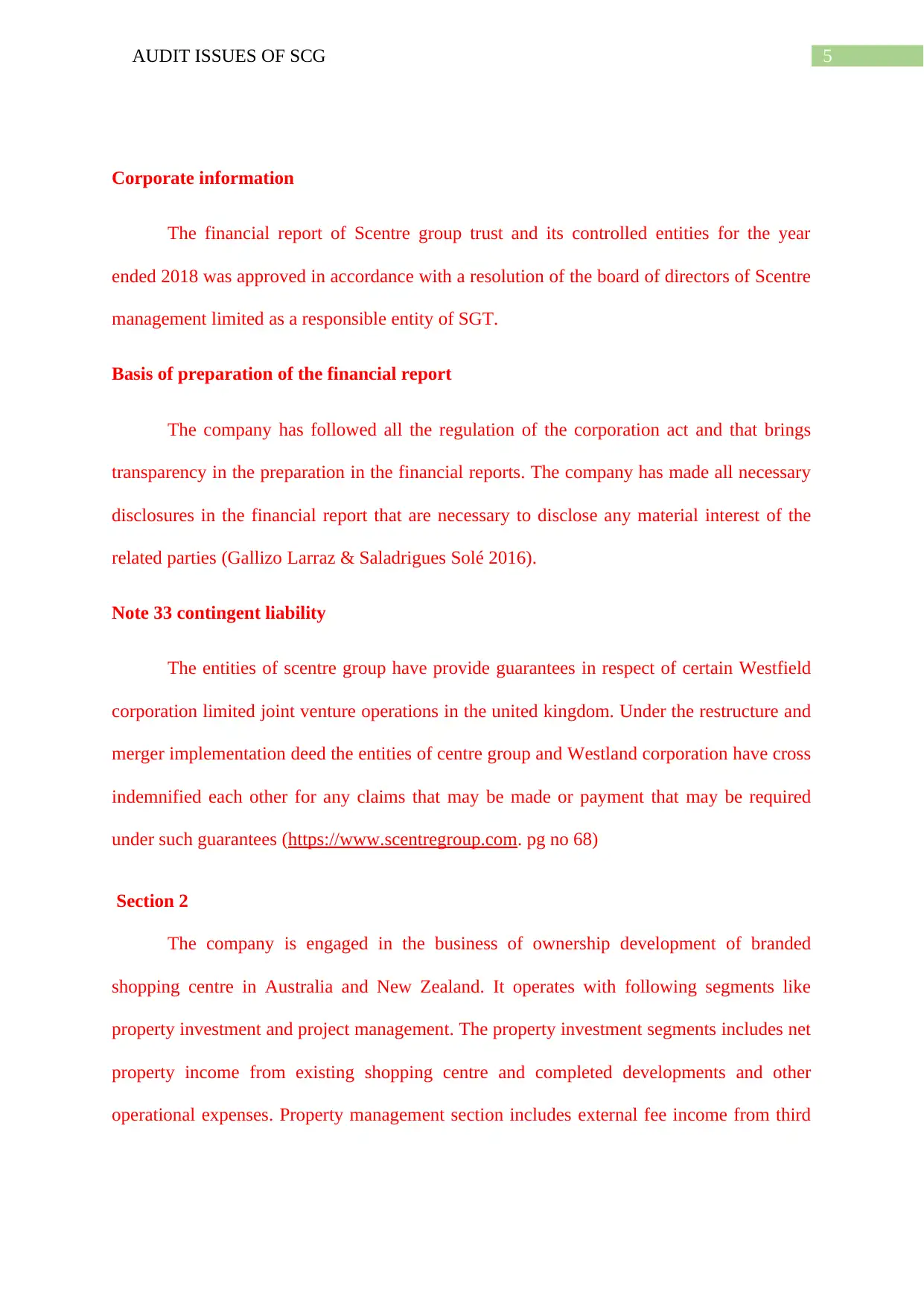
5AUDIT ISSUES OF SCG
Corporate information
The financial report of Scentre group trust and its controlled entities for the year
ended 2018 was approved in accordance with a resolution of the board of directors of Scentre
management limited as a responsible entity of SGT.
Basis of preparation of the financial report
The company has followed all the regulation of the corporation act and that brings
transparency in the preparation in the financial reports. The company has made all necessary
disclosures in the financial report that are necessary to disclose any material interest of the
related parties (Gallizo Larraz & Saladrigues Solé 2016).
Note 33 contingent liability
The entities of scentre group have provide guarantees in respect of certain Westfield
corporation limited joint venture operations in the united kingdom. Under the restructure and
merger implementation deed the entities of centre group and Westland corporation have cross
indemnified each other for any claims that may be made or payment that may be required
under such guarantees (https://www.scentregroup.com. pg no 68)
Section 2
The company is engaged in the business of ownership development of branded
shopping centre in Australia and New Zealand. It operates with following segments like
property investment and project management. The property investment segments includes net
property income from existing shopping centre and completed developments and other
operational expenses. Property management section includes external fee income from third
Corporate information
The financial report of Scentre group trust and its controlled entities for the year
ended 2018 was approved in accordance with a resolution of the board of directors of Scentre
management limited as a responsible entity of SGT.
Basis of preparation of the financial report
The company has followed all the regulation of the corporation act and that brings
transparency in the preparation in the financial reports. The company has made all necessary
disclosures in the financial report that are necessary to disclose any material interest of the
related parties (Gallizo Larraz & Saladrigues Solé 2016).
Note 33 contingent liability
The entities of scentre group have provide guarantees in respect of certain Westfield
corporation limited joint venture operations in the united kingdom. Under the restructure and
merger implementation deed the entities of centre group and Westland corporation have cross
indemnified each other for any claims that may be made or payment that may be required
under such guarantees (https://www.scentregroup.com. pg no 68)
Section 2
The company is engaged in the business of ownership development of branded
shopping centre in Australia and New Zealand. It operates with following segments like
property investment and project management. The property investment segments includes net
property income from existing shopping centre and completed developments and other
operational expenses. Property management section includes external fee income from third
⊘ This is a preview!⊘
Do you want full access?
Subscribe today to unlock all pages.

Trusted by 1+ million students worldwide
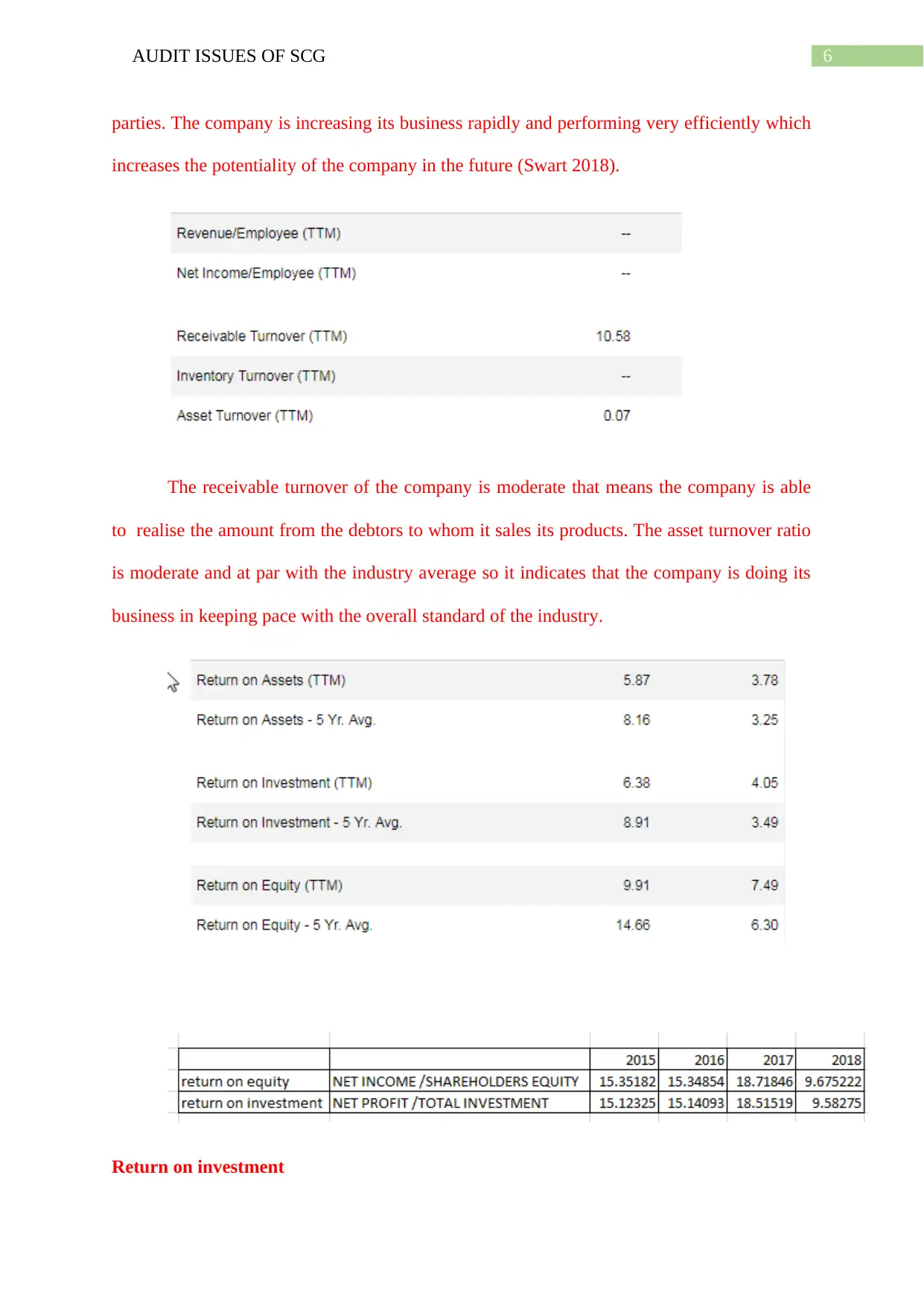
6AUDIT ISSUES OF SCG
parties. The company is increasing its business rapidly and performing very efficiently which
increases the potentiality of the company in the future (Swart 2018).
The receivable turnover of the company is moderate that means the company is able
to realise the amount from the debtors to whom it sales its products. The asset turnover ratio
is moderate and at par with the industry average so it indicates that the company is doing its
business in keeping pace with the overall standard of the industry.
Return on investment
parties. The company is increasing its business rapidly and performing very efficiently which
increases the potentiality of the company in the future (Swart 2018).
The receivable turnover of the company is moderate that means the company is able
to realise the amount from the debtors to whom it sales its products. The asset turnover ratio
is moderate and at par with the industry average so it indicates that the company is doing its
business in keeping pace with the overall standard of the industry.
Return on investment
Paraphrase This Document
Need a fresh take? Get an instant paraphrase of this document with our AI Paraphraser
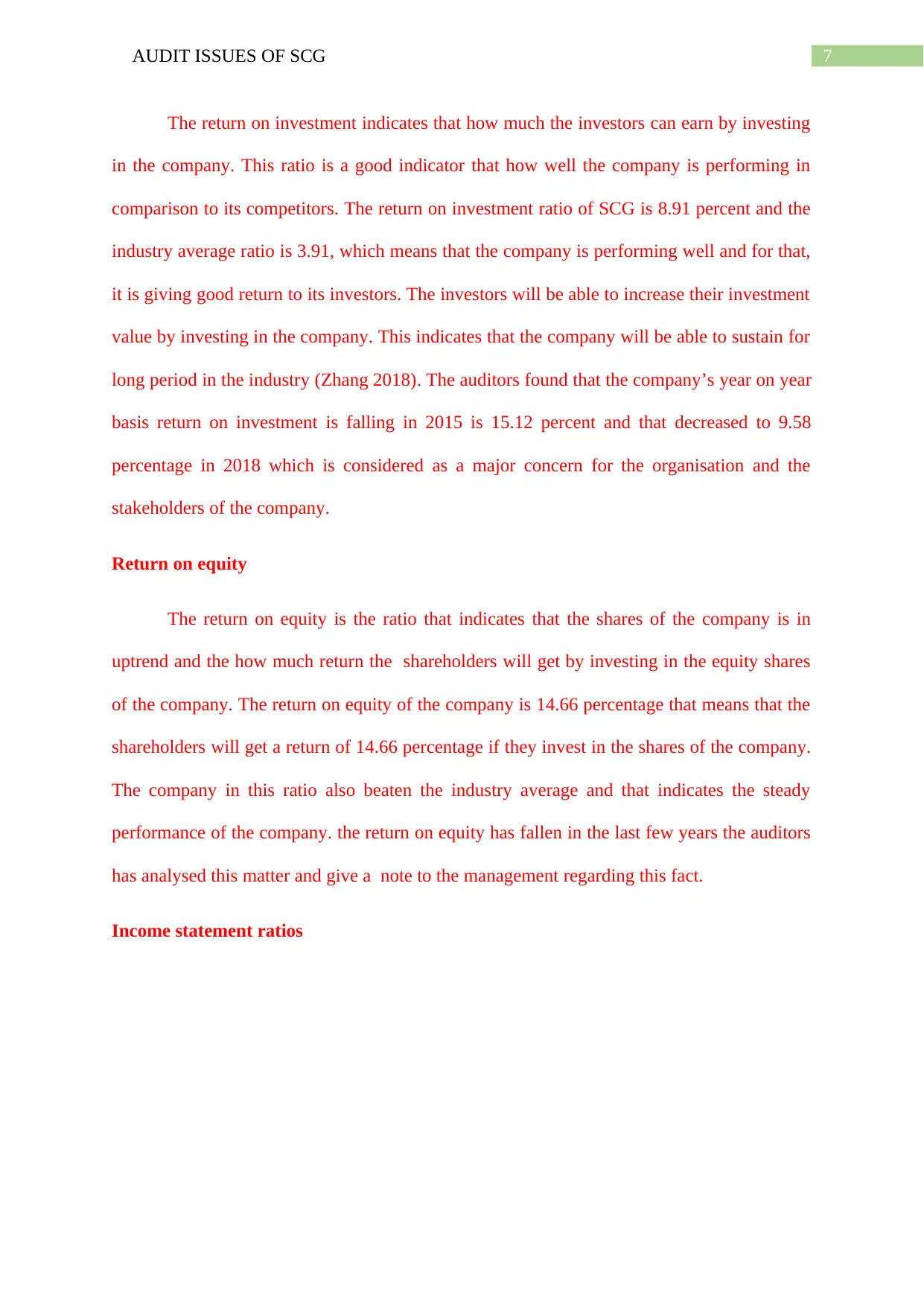
7AUDIT ISSUES OF SCG
The return on investment indicates that how much the investors can earn by investing
in the company. This ratio is a good indicator that how well the company is performing in
comparison to its competitors. The return on investment ratio of SCG is 8.91 percent and the
industry average ratio is 3.91, which means that the company is performing well and for that,
it is giving good return to its investors. The investors will be able to increase their investment
value by investing in the company. This indicates that the company will be able to sustain for
long period in the industry (Zhang 2018). The auditors found that the company’s year on year
basis return on investment is falling in 2015 is 15.12 percent and that decreased to 9.58
percentage in 2018 which is considered as a major concern for the organisation and the
stakeholders of the company.
Return on equity
The return on equity is the ratio that indicates that the shares of the company is in
uptrend and the how much return the shareholders will get by investing in the equity shares
of the company. The return on equity of the company is 14.66 percentage that means that the
shareholders will get a return of 14.66 percentage if they invest in the shares of the company.
The company in this ratio also beaten the industry average and that indicates the steady
performance of the company. the return on equity has fallen in the last few years the auditors
has analysed this matter and give a note to the management regarding this fact.
Income statement ratios
The return on investment indicates that how much the investors can earn by investing
in the company. This ratio is a good indicator that how well the company is performing in
comparison to its competitors. The return on investment ratio of SCG is 8.91 percent and the
industry average ratio is 3.91, which means that the company is performing well and for that,
it is giving good return to its investors. The investors will be able to increase their investment
value by investing in the company. This indicates that the company will be able to sustain for
long period in the industry (Zhang 2018). The auditors found that the company’s year on year
basis return on investment is falling in 2015 is 15.12 percent and that decreased to 9.58
percentage in 2018 which is considered as a major concern for the organisation and the
stakeholders of the company.
Return on equity
The return on equity is the ratio that indicates that the shares of the company is in
uptrend and the how much return the shareholders will get by investing in the equity shares
of the company. The return on equity of the company is 14.66 percentage that means that the
shareholders will get a return of 14.66 percentage if they invest in the shares of the company.
The company in this ratio also beaten the industry average and that indicates the steady
performance of the company. the return on equity has fallen in the last few years the auditors
has analysed this matter and give a note to the management regarding this fact.
Income statement ratios
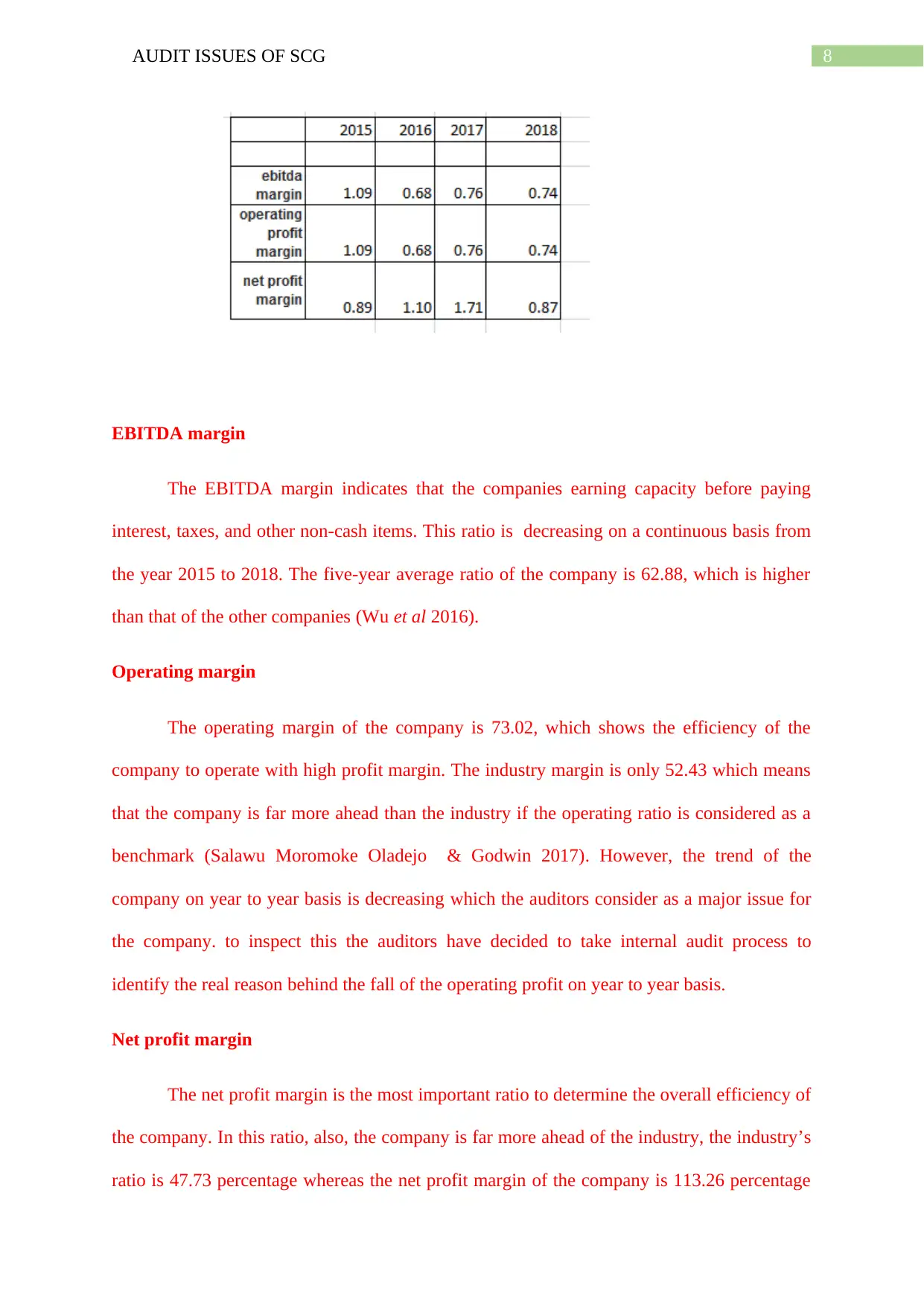
8AUDIT ISSUES OF SCG
EBITDA margin
The EBITDA margin indicates that the companies earning capacity before paying
interest, taxes, and other non-cash items. This ratio is decreasing on a continuous basis from
the year 2015 to 2018. The five-year average ratio of the company is 62.88, which is higher
than that of the other companies (Wu et al 2016).
Operating margin
The operating margin of the company is 73.02, which shows the efficiency of the
company to operate with high profit margin. The industry margin is only 52.43 which means
that the company is far more ahead than the industry if the operating ratio is considered as a
benchmark (Salawu Moromoke Oladejo & Godwin 2017). However, the trend of the
company on year to year basis is decreasing which the auditors consider as a major issue for
the company. to inspect this the auditors have decided to take internal audit process to
identify the real reason behind the fall of the operating profit on year to year basis.
Net profit margin
The net profit margin is the most important ratio to determine the overall efficiency of
the company. In this ratio, also, the company is far more ahead of the industry, the industry’s
ratio is 47.73 percentage whereas the net profit margin of the company is 113.26 percentage
EBITDA margin
The EBITDA margin indicates that the companies earning capacity before paying
interest, taxes, and other non-cash items. This ratio is decreasing on a continuous basis from
the year 2015 to 2018. The five-year average ratio of the company is 62.88, which is higher
than that of the other companies (Wu et al 2016).
Operating margin
The operating margin of the company is 73.02, which shows the efficiency of the
company to operate with high profit margin. The industry margin is only 52.43 which means
that the company is far more ahead than the industry if the operating ratio is considered as a
benchmark (Salawu Moromoke Oladejo & Godwin 2017). However, the trend of the
company on year to year basis is decreasing which the auditors consider as a major issue for
the company. to inspect this the auditors have decided to take internal audit process to
identify the real reason behind the fall of the operating profit on year to year basis.
Net profit margin
The net profit margin is the most important ratio to determine the overall efficiency of
the company. In this ratio, also, the company is far more ahead of the industry, the industry’s
ratio is 47.73 percentage whereas the net profit margin of the company is 113.26 percentage
⊘ This is a preview!⊘
Do you want full access?
Subscribe today to unlock all pages.

Trusted by 1+ million students worldwide

9AUDIT ISSUES OF SCG
which is double than the industry average this shows how effectively the organisation has
performed.
The key risk areas for the audit is that the company is beating the industry in all the
ratios though the sector of the business is not giving good results this might be a area where
the auditor may address in the audit plan (Choudhary Merkley & Schipper 2017). In respect
of the year to year basis performance the company’s result is poor but in comparison to the
industry it is far more ahead of the other competitors.
The main five financial assertions are stated below
Existence
The assertion of existence means that the assets liabilities and the shareholders equity
balances that are appearing in the financial reports of the company really exist or not.
Completeness
The assertion of completeness is an assertion that the financial statements made are
thorough and include every item that should be included in the statement for a given
accounting period.
Rights and obligation
The assertion of rights and obligation is a basic assertion that all assets and liabilities
included in a financial statement belong to the company that is issuing the statements.
Accuracy and valuation
which is double than the industry average this shows how effectively the organisation has
performed.
The key risk areas for the audit is that the company is beating the industry in all the
ratios though the sector of the business is not giving good results this might be a area where
the auditor may address in the audit plan (Choudhary Merkley & Schipper 2017). In respect
of the year to year basis performance the company’s result is poor but in comparison to the
industry it is far more ahead of the other competitors.
The main five financial assertions are stated below
Existence
The assertion of existence means that the assets liabilities and the shareholders equity
balances that are appearing in the financial reports of the company really exist or not.
Completeness
The assertion of completeness is an assertion that the financial statements made are
thorough and include every item that should be included in the statement for a given
accounting period.
Rights and obligation
The assertion of rights and obligation is a basic assertion that all assets and liabilities
included in a financial statement belong to the company that is issuing the statements.
Accuracy and valuation
Paraphrase This Document
Need a fresh take? Get an instant paraphrase of this document with our AI Paraphraser
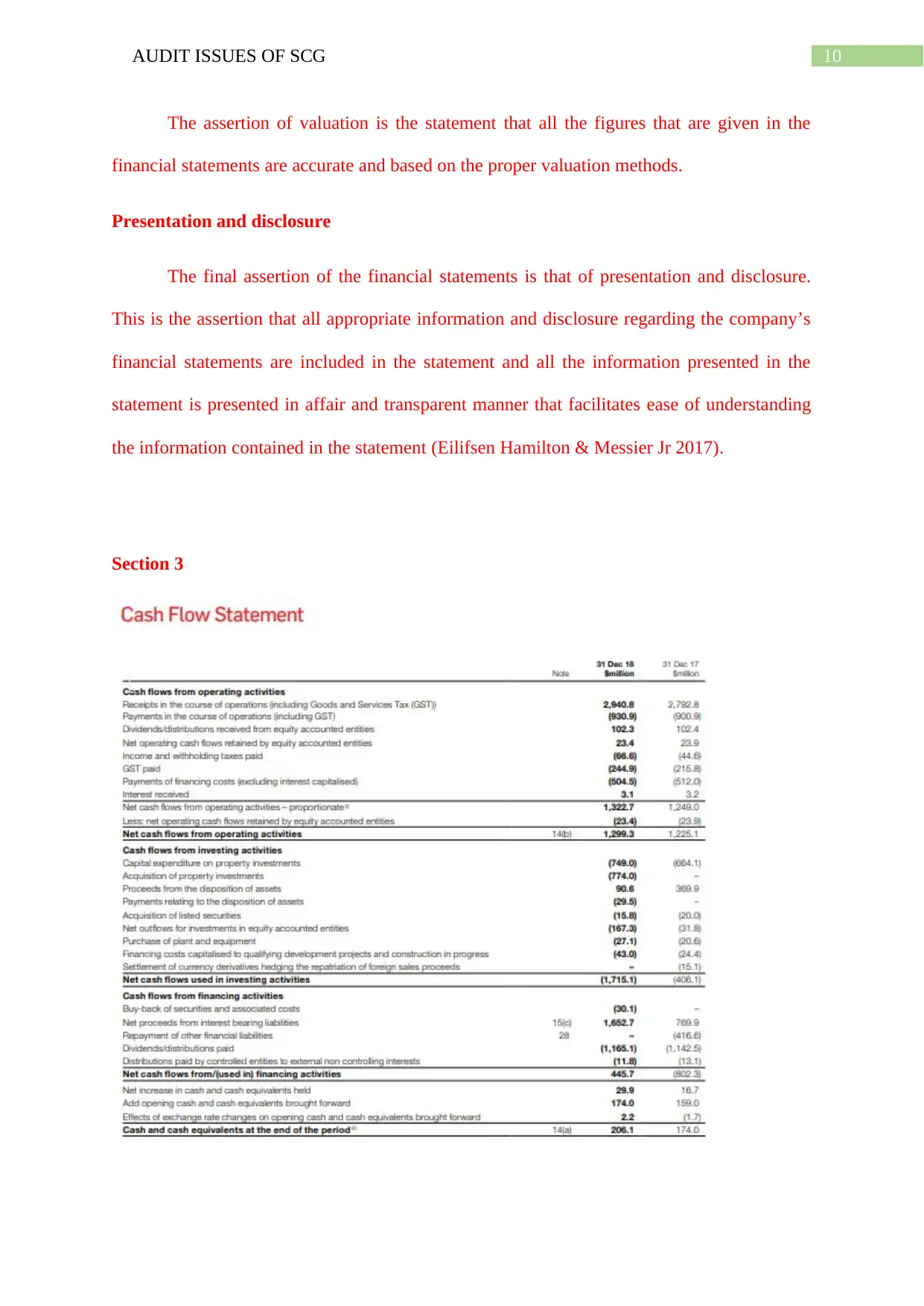
10AUDIT ISSUES OF SCG
The assertion of valuation is the statement that all the figures that are given in the
financial statements are accurate and based on the proper valuation methods.
Presentation and disclosure
The final assertion of the financial statements is that of presentation and disclosure.
This is the assertion that all appropriate information and disclosure regarding the company’s
financial statements are included in the statement and all the information presented in the
statement is presented in affair and transparent manner that facilitates ease of understanding
the information contained in the statement (Eilifsen Hamilton & Messier Jr 2017).
Section 3
The assertion of valuation is the statement that all the figures that are given in the
financial statements are accurate and based on the proper valuation methods.
Presentation and disclosure
The final assertion of the financial statements is that of presentation and disclosure.
This is the assertion that all appropriate information and disclosure regarding the company’s
financial statements are included in the statement and all the information presented in the
statement is presented in affair and transparent manner that facilitates ease of understanding
the information contained in the statement (Eilifsen Hamilton & Messier Jr 2017).
Section 3
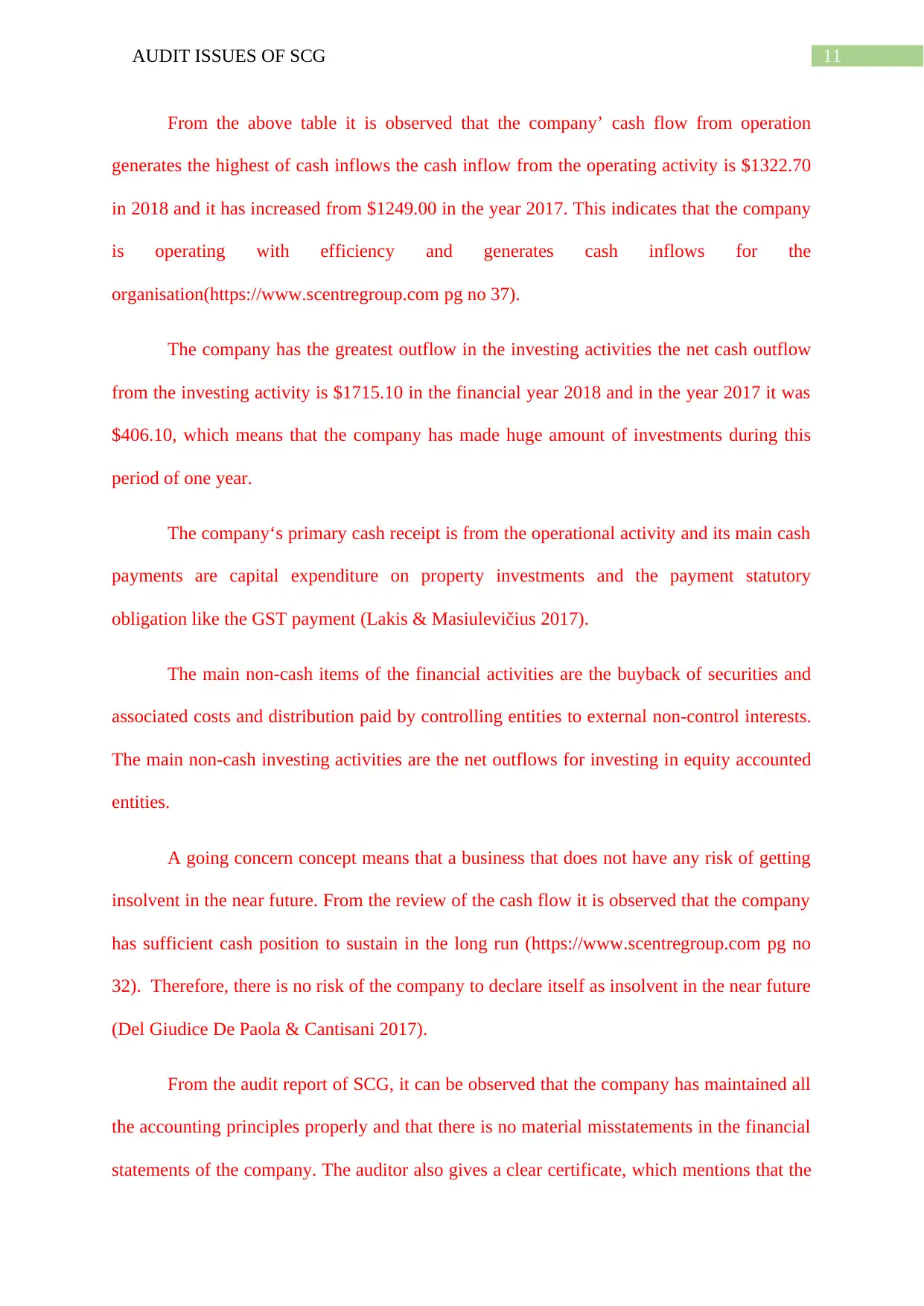
11AUDIT ISSUES OF SCG
From the above table it is observed that the company’ cash flow from operation
generates the highest of cash inflows the cash inflow from the operating activity is $1322.70
in 2018 and it has increased from $1249.00 in the year 2017. This indicates that the company
is operating with efficiency and generates cash inflows for the
organisation(https://www.scentregroup.com pg no 37).
The company has the greatest outflow in the investing activities the net cash outflow
from the investing activity is $1715.10 in the financial year 2018 and in the year 2017 it was
$406.10, which means that the company has made huge amount of investments during this
period of one year.
The company‘s primary cash receipt is from the operational activity and its main cash
payments are capital expenditure on property investments and the payment statutory
obligation like the GST payment (Lakis & Masiulevičius 2017).
The main non-cash items of the financial activities are the buyback of securities and
associated costs and distribution paid by controlling entities to external non-control interests.
The main non-cash investing activities are the net outflows for investing in equity accounted
entities.
A going concern concept means that a business that does not have any risk of getting
insolvent in the near future. From the review of the cash flow it is observed that the company
has sufficient cash position to sustain in the long run (https://www.scentregroup.com pg no
32). Therefore, there is no risk of the company to declare itself as insolvent in the near future
(Del Giudice De Paola & Cantisani 2017).
From the audit report of SCG, it can be observed that the company has maintained all
the accounting principles properly and that there is no material misstatements in the financial
statements of the company. The auditor also gives a clear certificate, which mentions that the
From the above table it is observed that the company’ cash flow from operation
generates the highest of cash inflows the cash inflow from the operating activity is $1322.70
in 2018 and it has increased from $1249.00 in the year 2017. This indicates that the company
is operating with efficiency and generates cash inflows for the
organisation(https://www.scentregroup.com pg no 37).
The company has the greatest outflow in the investing activities the net cash outflow
from the investing activity is $1715.10 in the financial year 2018 and in the year 2017 it was
$406.10, which means that the company has made huge amount of investments during this
period of one year.
The company‘s primary cash receipt is from the operational activity and its main cash
payments are capital expenditure on property investments and the payment statutory
obligation like the GST payment (Lakis & Masiulevičius 2017).
The main non-cash items of the financial activities are the buyback of securities and
associated costs and distribution paid by controlling entities to external non-control interests.
The main non-cash investing activities are the net outflows for investing in equity accounted
entities.
A going concern concept means that a business that does not have any risk of getting
insolvent in the near future. From the review of the cash flow it is observed that the company
has sufficient cash position to sustain in the long run (https://www.scentregroup.com pg no
32). Therefore, there is no risk of the company to declare itself as insolvent in the near future
(Del Giudice De Paola & Cantisani 2017).
From the audit report of SCG, it can be observed that the company has maintained all
the accounting principles properly and that there is no material misstatements in the financial
statements of the company. The auditor also gives a clear certificate, which mentions that the
⊘ This is a preview!⊘
Do you want full access?
Subscribe today to unlock all pages.

Trusted by 1+ million students worldwide
1 out of 16
Related Documents
Your All-in-One AI-Powered Toolkit for Academic Success.
+13062052269
info@desklib.com
Available 24*7 on WhatsApp / Email
![[object Object]](/_next/static/media/star-bottom.7253800d.svg)
Unlock your academic potential
Copyright © 2020–2025 A2Z Services. All Rights Reserved. Developed and managed by ZUCOL.





